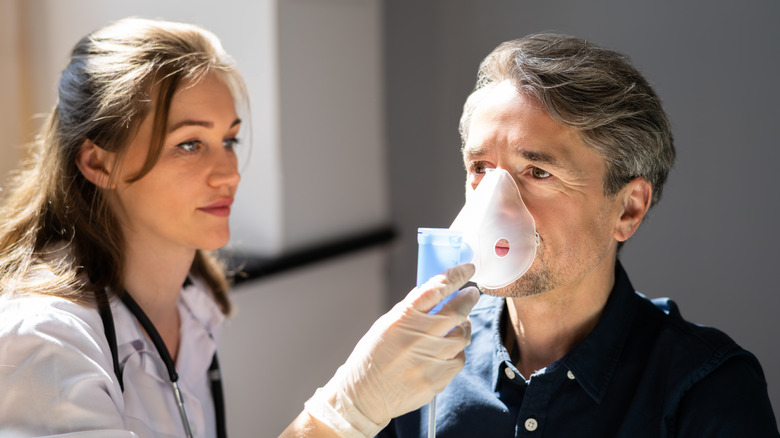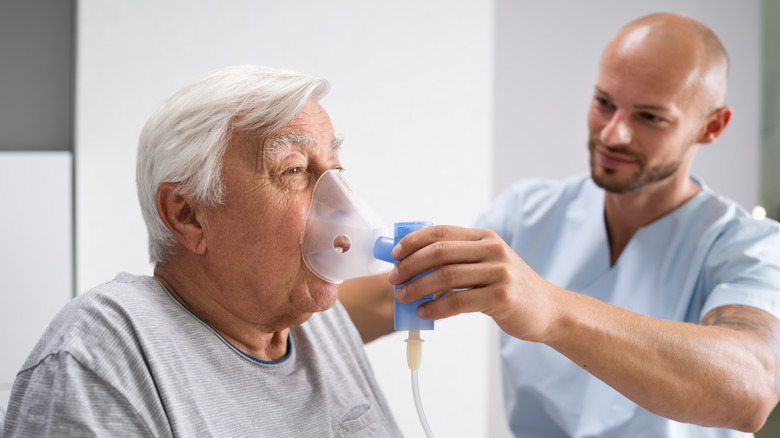The 4 Stages Of COPD Explained
COPD (chronic obstructive pulmonary disease) is a chronic respiratory condition characterized by airflow limitation. The condition affects the lungs and makes it difficult for people to breathe. COPD is typically caused by long-term exposure to irritating gases or particles, such as those found in cigarette smoke (via the Mayo Clinic).
According to the American Lung Association, as many as 12.5 million Americans have COPD. However, there may be millions more undiagnosed cases. The diagnosis of COPD is based on spirometry testing, which measures the amount of air a person can exhale forcefully and how quickly they can do it. Spirometry is a simple, non-invasive test that can help your doctor determine how advanced your COPD is and can also be used to gauge whether or not your treatment plan is working as intended.
COPD is a progressive condition that typically develops slowly over time. The severity of COPD is usually classified using a staging system known as GOLD (Global Initiative for Chronic Obstructive Lung Disease).
What is the GOLD system of categorizing COPD?
The GOLD (Global Initiative for Chronic Obstructive Lung Disease) system is a widely used classification system for the severity of COPD. The GOLD system categorizes COPD into one of four stages — mild, moderate, severe, and very severe — based on spirometry test results.
The two most important spirometry measurements are FEV1 (forced expiratory volume in one second) and FVC (forced vital capacity). FEV1 measures the air that a person can exhale in one second, while FVC measures the total amount of air that a person can exhale forcefully, according to Healthline.
The GOLD system uses the FEV1/FVC ratio to determine the presence of airflow limitation. An FEV1/FVC ratio of less than 0.70 is considered COPD, as it indicates that the airflow going in and out of your lungs is restricted. Based on the severity of airflow limitation, the GOLD system will classify COPD from mild to very severe.
Stage 1 - mild COPD
Stage 1 of COPD is also known as mild COPD, per the Global Initiative for Chronic Obstructive Lung Disease (GOLD). It is the earliest stage of the disease and is characterized by mild airflow limitation. People with stage 1 COPD may not have any symptoms or experience mild symptoms that do not significantly impact their daily activities. Common symptoms at this stage include a lingering cough and moments of breathlessness.
Although stage 1 COPD is considered mild, it is still a chronic and progressive disease that requires appropriate management. Treatment goals in stage 1 COPD are to prevent disease progression and alleviate symptoms. Smoking cessation is the most important intervention, as it can slow the progression of the disease and reduce the risk of exacerbations. Other interventions may include getting the right nutrition, receiving flu and pneumonia vaccines, and taking bronchodilators combined with inhaled corticosteroids, according to Medical News Today.
Stage 2 - moderate COPD
Stage 2 of COPD is also known as moderate COPD. It is characterized by a more significant airflow limitation than in the first stage. In this stage, the FEV1 is between 50% and 80% of the predicted value, indicating a moderate reduction in lung function (via GOLD).
In stage 2 COPD, patients may experience more severe symptoms of breathlessness, coughing, and sputum production. These symptoms can moderately impact daily activities such as walking and exercising and may be more noticeable to the patient than in stage 1 COPD.
Smoking cessation is still the most important intervention at this stage, as it can slow the progression of the disease and reduce the risk of exacerbations. Treating COPD at this stage varies depending on the individual but may include pulmonary rehabilitation and supplementary oxygen therapy in addition to a diet and exercise routine, according to Medical News Today.
Stage 3 - severe COPD
Stage 3 of COPD is also known as severe COPD. In this stage, the airflow limitation is even more significant than in stage 2, and the FEV1 is between 30% and 50% of the predicted value (via GOLD). This indicates a severe reduction in lung function.
Patients with stage 3 COPD are at high risk of exacerbations — which occurs when symptoms suddenly become worse, sometimes due to physical activity — and can lead to hospitalization and decreased lung function. Patients at this stage typically experience significant symptoms such as extreme breathlessness, wheezing, cough with mucus production, weight loss, and tightness in the chest. These symptoms can substantially impact daily activities and result in a decreased quality of life.
To reduce the risk of exacerbations, people with stage 3 COPD may be prescribed a combination of bronchodilators, inhaled corticosteroids, and antibiotics, per Healthline. In some cases, patients with stage 3 COPD may be candidates for lung surgery, which can improve lung function and quality of life.
Stage 4 - very severe COPD
Stage 4 of COPD is the most severe stage of the disease. In this stage, the airflow limitation is very severe, with an FEV1 less than 30% of the predicted value (via GOLD). The symptoms are similar to stage 3 but may also include bacterial infections and acute or chronic respiratory failure. Symptoms at this stage will severely limit a patient's ability to carry out daily activities.
The treatment plan for stage 4 COPD will depend on individual patient needs and medical history and should be discussed with a doctor. As with the previous stages, bronchodilators and corticosteroids are commonly used to improve lung function and reduce inflammation, and oxygen therapy may be needed as well, according to Medical News Today. Surgery, including lung volume reduction surgery, bullectomy, or a lung transplant, might be recommended in other cases. End-of-life care is also important in stage 4 COPD, as patients may require palliative care or hospice services to manage symptoms and improve their quality of life (via WebMD).






